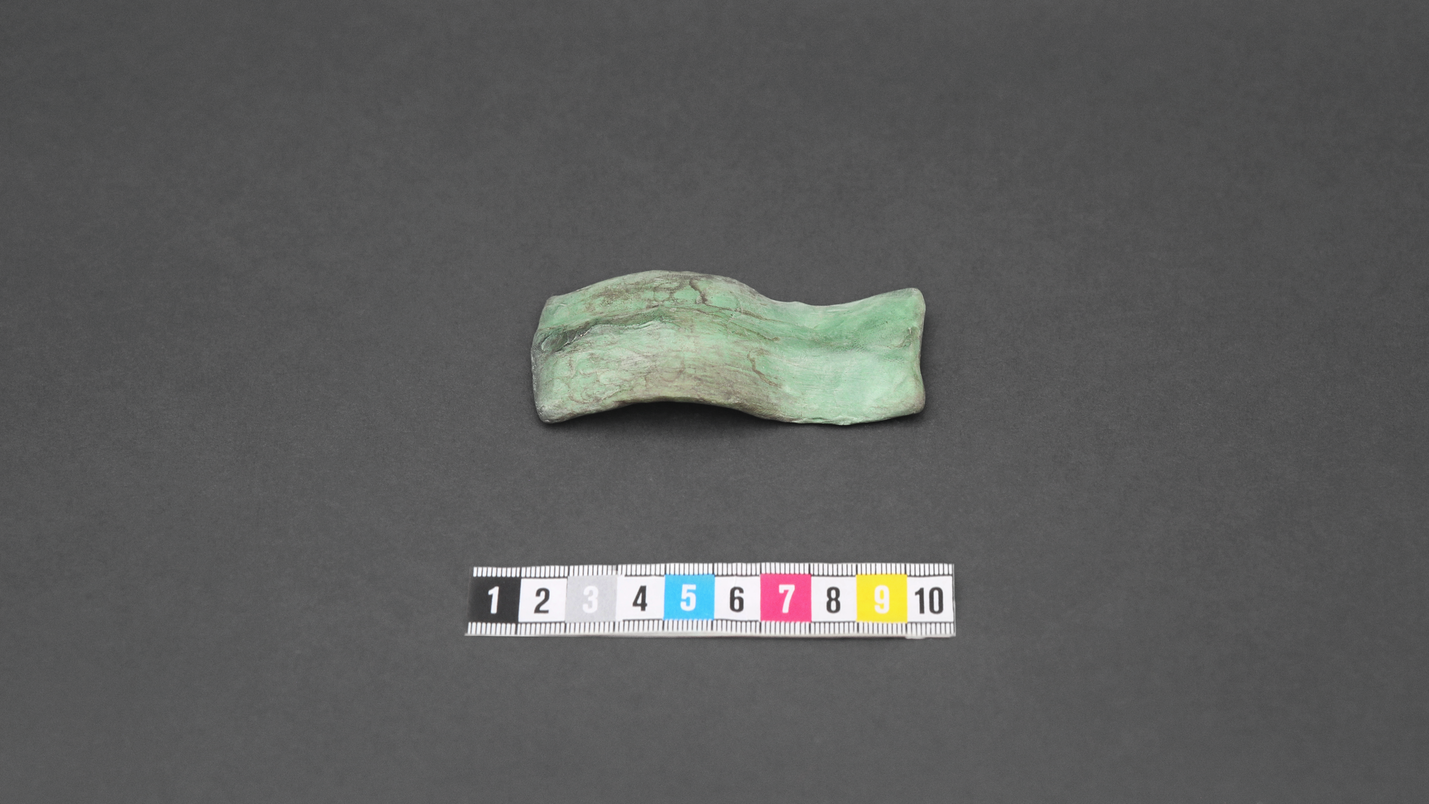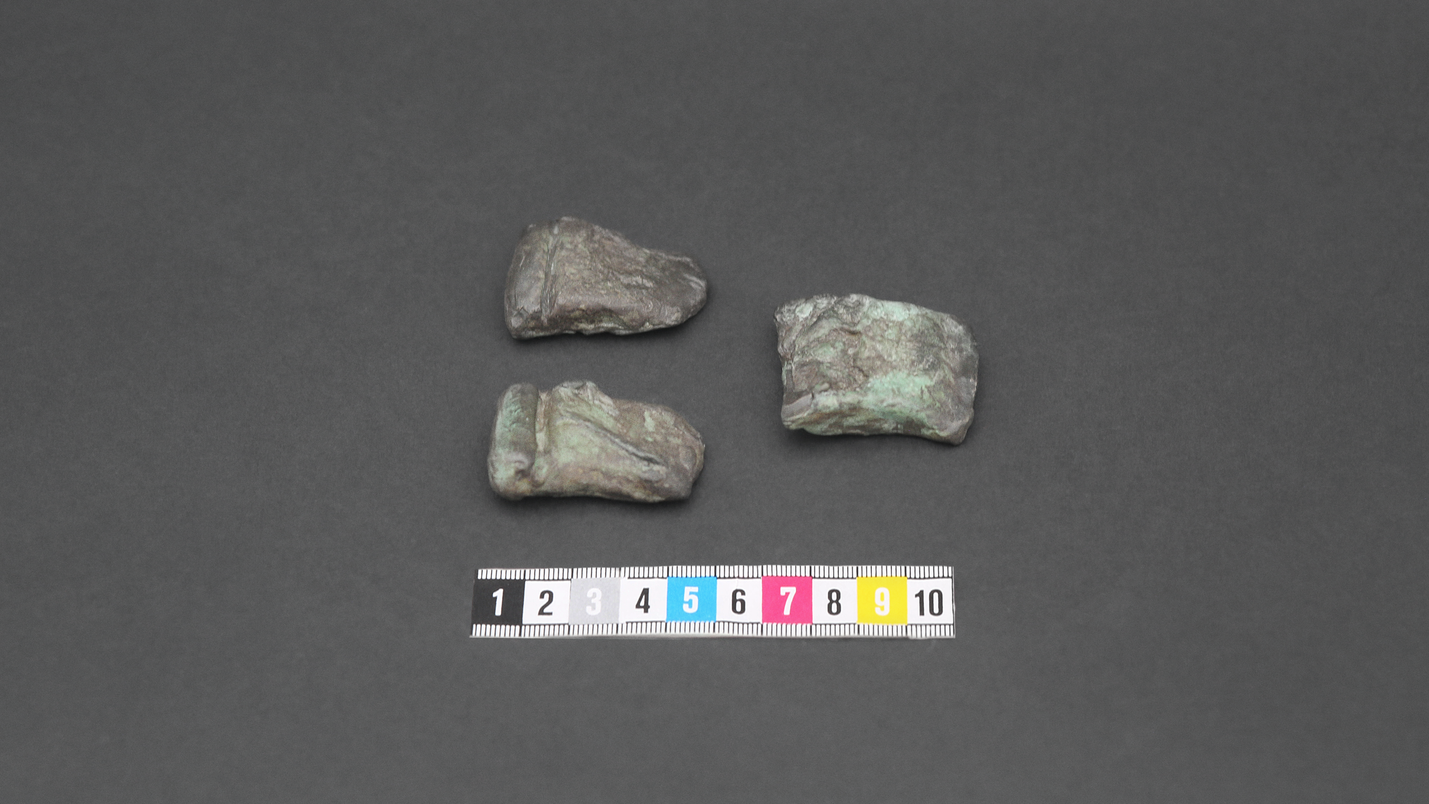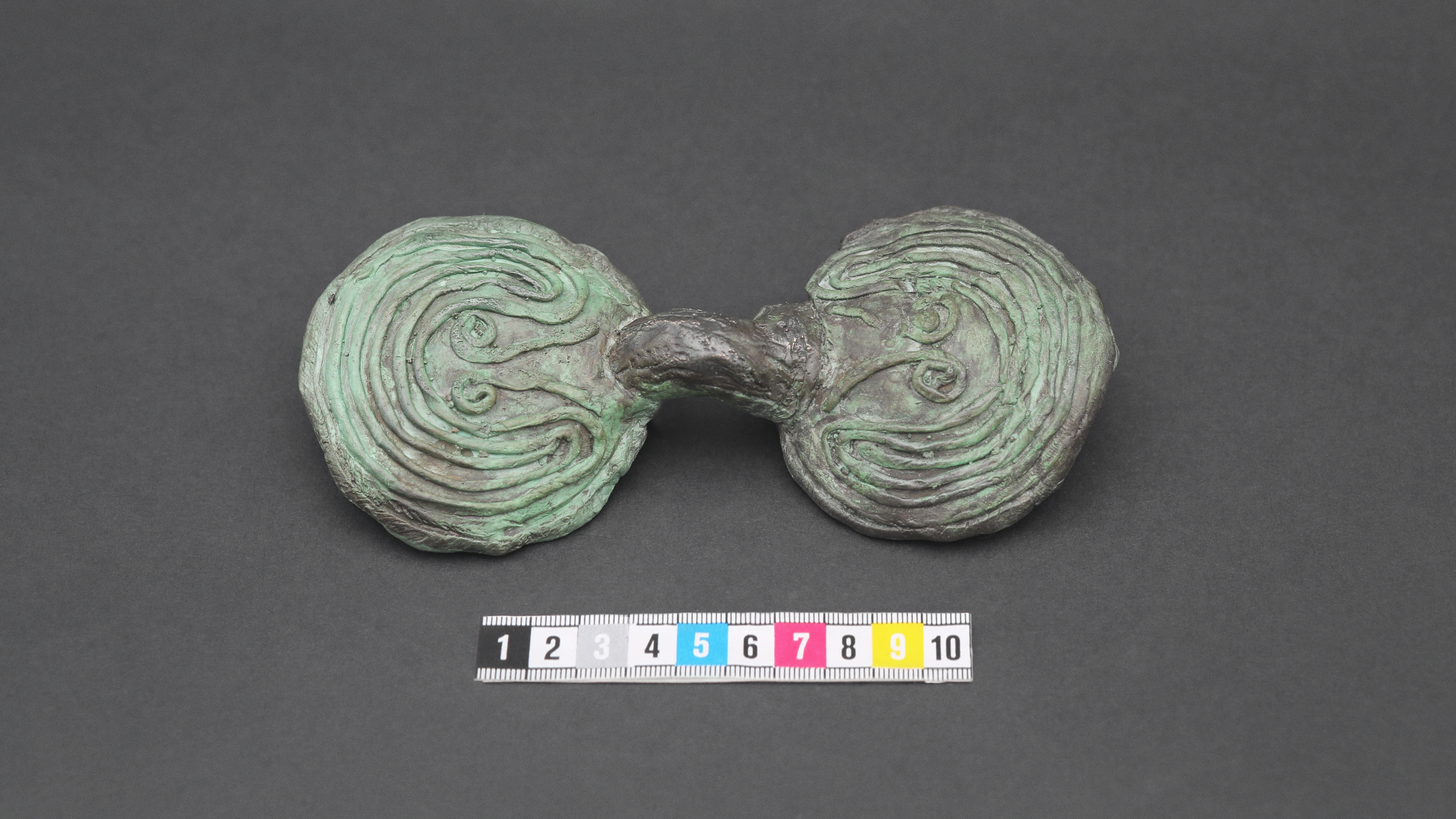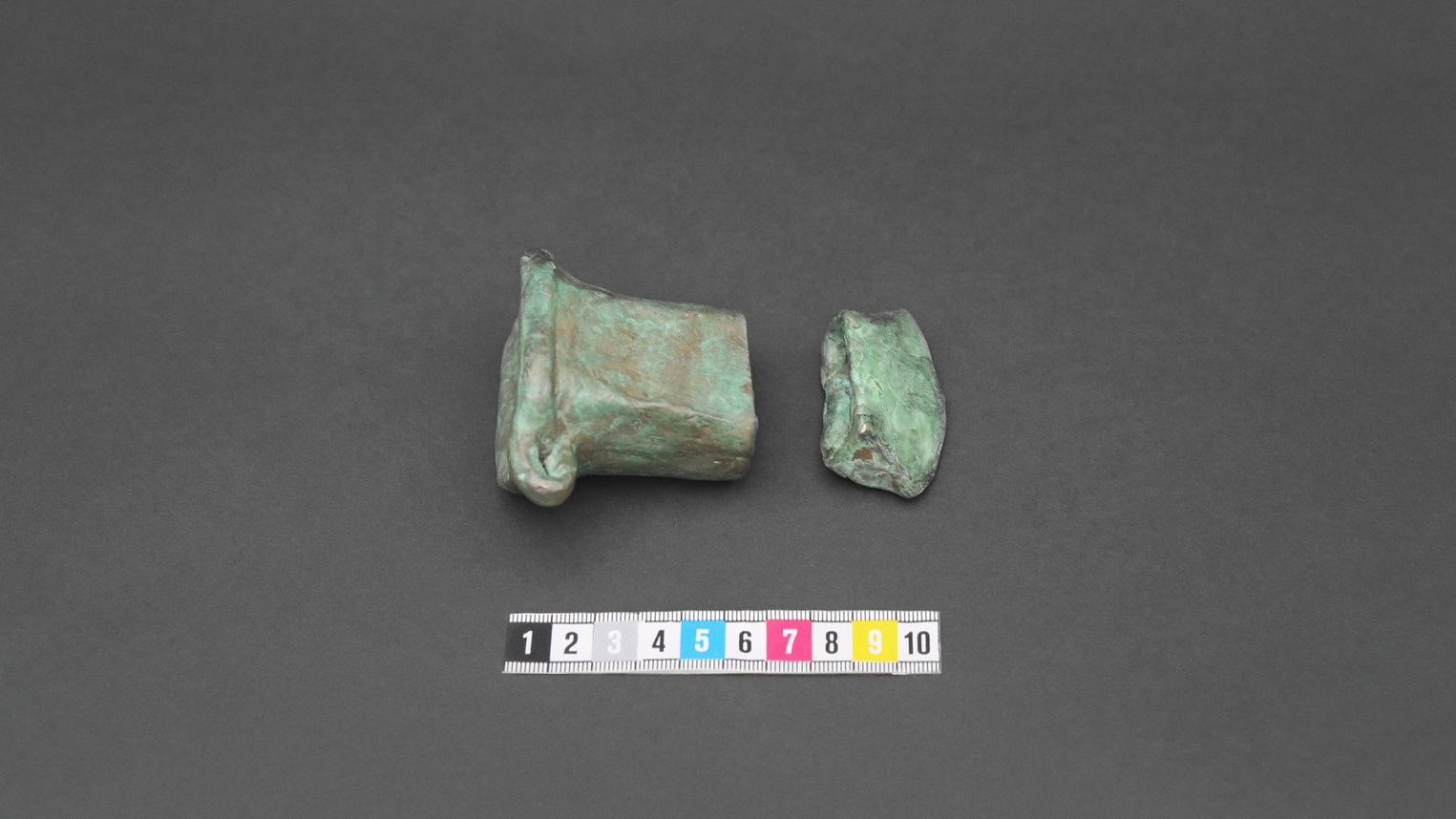When I was invited to Sundsvall’s Museum to have a solo exhibition curated by Lejla Porovic during the third research period (2022-2023), I chose to make replicas of the bronze objects; I made eight of the objects in wax and delivered them to the bronze foundry. They became credible enough to give the illusion of being the genuine bronze objects of the Bronze Age. In the exhibition, I showed seven bronze objects. Instead of having the video work Volver tillbaka in the video essay Collect the (un)connected and (re)connect the uncollected, I had the grounds without a house as an object in glass and sand on a podium in the exhibition room. Since I investigated my genetic origins, it made sense to let an old work become part of the new. Volver tillbaka was the first work I made as a student at Konstfack. It deals with my migration history in an objective way. I wanted to introduce a discussion about why I work with the issues I do in my artistic practice. But before the final version, that was exhibited at Sundsvalls Museum, I chose to remove Volver tillbaka from the video essay to give the hypothesis more strength. I also chose to remove the claim that I had found the answer to why Chileans as a group stayed in Sweden to a greater degree than other Latin American groups that came in the 1970s. It falls on its own absurdity, because there shouldn’t be such a big difference between a Chilean and an Argentine, Bolivian, Uruguayan or other Latin Americans, whose countries were hit by military coups, and who received political asylum in Sweden, but returned or moved on to other European countries. Rather, it has more to do with other factors. For example, that many Argentinians had relatives in other European countries, such as Italy and Spain, and therefore moved there, and that the dictatorship in Chile lasted longer than in other Latinamerican countries.
Sundsvall’s Museum is a municipal museum with the task of conveying the city’s history. They have a natural history collection and a mission of showing contemporary art. I thought it was particularly fitting that when people visit other rooms in the museum, there are authentic archaeological and ethnological finds in glass displays. In the Collect and (re)connect exhibition, these replicas of the Bronze Age finds were presented in the same way as in the museum’s historical department. I replaced the stills from the video in version 2 with photographs of the bronze replicas I produced for the exhibition.
From an existential-ontological point of view the ”not-at-home” must be the most primordial phenomenon.
Heidegger
Cuando fui invitada al Museo Sundsvall para una exposición individual, comisariada por Lejla Porovic, durante el tercer periodo de investigación (2022-2023). Opté por hacer réplicas de los objetos de bronce, de los que me había hablado el arqueólogo Hans Olsson. Hice ocho de los objetos en cera, y los entregué a una fundición de bronce. El resultado de los objetos, fue el de dar la ilusión de ser auténticos artefactos de la Edad de Bronce.
En la exposición se mostraron siete objetos de bronce, y cuatro fotografías de los objetos. Frente a la posibilidad de incluir la obra de vídeo Volver, en la sección de vídeo, que tenía en su tercera versión. Decidí mejor exponer los cimientos de la casa sin casa, consistente en un objeto de vidrio y arena, sobre un podio en la sala de exposiciones.
La razón por la que incorporé la obra antigua a la nueva, fue porque estaba explorando mis orígenes genéticos. Por lo tanto, también era necesario retroceder en mi carrera artística. Volver, fue la primera obra de vídeo que hice como estudiante en Konstfack, que trata sobre mi historia migratoria de forma objetiva. De esta manera incorporé una discusión acerca de por qué trabajo con los temas que investigo en mi obra artística, y prescindí de cuestiones como el material, el color y la forma. Sin embargo, antes de exponer la versión final en el Museo de Sundsvall, decidí eliminar Volver de la sección de vídeo, para dar mayor eficacia narrativa. También pude constatar que había encontrado la respuesta acerca de por qué los chilenos como grupo se han quedado en Suecia, en relación a otros grupos latinoamericanos llegados en los años setenta. No tiene sentido pensar grandes diferencias entre chilenos, argentinos, bolivianos, uruguayos, u otros grupos latinoamericanos, a los que se les concedió asilo político en Suecia por los golpes militares. Los otros grupos de refugiados latinoamericanos, regresaron o se trasladaron a otros países europeos. Posiblemente esta circunstancia tenga que ver con el hecho de que la dictadura en Chile, duró mucho más que en los otros países de la región.
El Museo de Sundsvall es un museo municipal, cuya misión es dar a conocer la historia de la ciudad. En su acervo el museo tiene una colección de historia natural, y también la misión de mostrar arte contemporáneo. Me pareció particularmente acertado que, cuando el visitante pasa a otra sala del museo, hubieran hallazgos arqueológicos y etnológicos en varias vitrinas. En la exposición Coleccionar y (re)conectar, las réplicas de los hallazgos de la Edad de Bronce, se presentaron del mismo modo que en la sección histórica del museo. En la segunda versión, sustituí las imágenes fijas del vídeo por fotografías de las réplicas de bronce que había producido para la exposición.
När jag blev inbjuden till Sundsvalls museum för en soloutställning kurerad av Lejla Porovic under den tredje researchperioden (2022-2023) valde jag att göra replikor av de bronsobjekten som arkeologen Hans Olsson berättade om. Jag tillverkade åtta av objekten i vax och levererade dem till ett bronsgjuteri. De blev tillräckligt trovärdiga för att inge illusionen av att vara de äkta fynd från bronsåldern. I utställningen visade jag sju bronsobjekt och i den exposition visar jag fyra fotografier av objekten. Istället för att ha med videoverket Volver tillbaka i videoessän som jag hade i version 3 så ställde jag ut husgrunden utan hus som ett objekt i glas och sand på ett podium i själva utställningsrummet. Min tanke med att föra in det äldre verket i det nya verket handlade om att eftersom jag undersöker mitt genetiska ursprung så var det nödvändigt att gå tillbaka i min konstnärliga bana. Volver tillbaka var det första videoverk som jag gjorde som student på Konstfack och som handlar om min migrationshistoria på ett objektivt sätt. Jag tänkte att jag ville föra in ett resonemang kring varför jag arbetar med de frågor som jag bearbetar i mitt konstnärliga arbete och inte enbart ägna mig åt material, färg och form. Inför den slutgiltiga versionen som ställdes ut på Sundsvalls museum valde jag dock att plocka bort Volver tillbaka från videoessän för att koncentrera berättelsen. Jag valde också bort att jag hade hittat svaret på varför chilenare som grupp har stannat i Sverige i högre utsträckning än andra latinamerikanska grupper som kom på 1970-talet. Den faller på sin egen orimlighet eftersom det inte borde vara så stor skillnad mellan chilenare, argentinare, bolivianer, uruguayare eller andra latinamerikanska grupper som fick politisk asyl i Sverige på grund av alla militärkupper. De andra latinamerikanska flyktinggrupperna återvände eller flyttade vidare till andra europeiska länder och det kan ha att göra med att diktaturen i Chile varade mycket längre än i de andra latinamerikanska länderna.
Just Sundsvalls museum är ett kommunalt museum som har uppdraget att förmedla stadens historia. Museet har även en naturhistorisk samling och ett uppdrag att visa samtidskonst. Jag tyckte att det passade särskilt väl att när besökaren går vidare till ett annat rum i museet så finns där arkeologiska och etnologiska äkta fynd i olika glasmontrar. I utställningen Collect and (re)connect fanns replikorna av bronsåldersfynden presenterade på samma sätt som i museets historiska avdelning. Stillbilderna från videon i version 2 bytte jag ut mot fotografier på bronsreplikorna som jag hade producerat inför utställningen.






